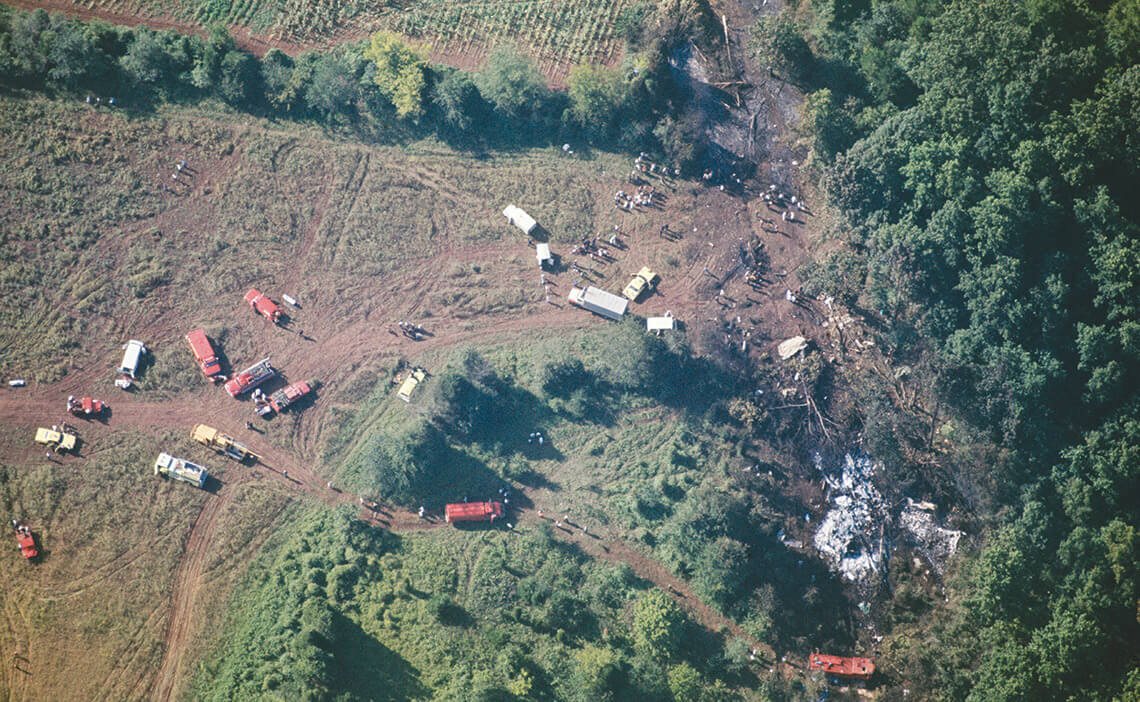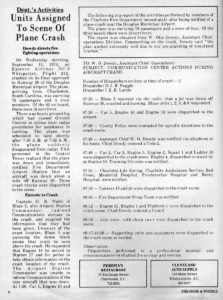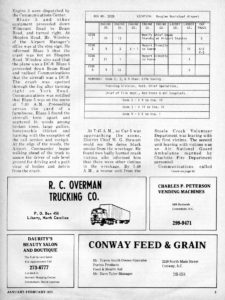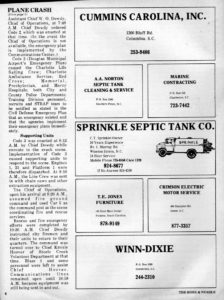This is an expanded version of a Facebook posting on November 24, 2022, and a blogs archive posting (PDF) from April 8, 2010.
Courtesy of the Don Sturkey Photographic Materials (P0070), North Carolina Collection, UNC-Chapel Hill Library, from Fatal Distraction by Philip Gerard in Our State magazine.
Contents
- Introduction
- Timeline
- Charlotte Fire Department Narrative
Introduction
On the morning on September 11, 1974, Eastern Air Lines Flight 212 crashed on approach to Douglas Municipal Airport in Charlotte. The Douglas DC-9-31 was carrying 78 passengers and 4 crew members. It crashed into a wooded area just short of the runway while on instrument approach in dense fog. The crash killed 71 people, including four who died later. It remains the worst plane crash in Charlotte history and the second-worst in North Carolina History.
The CFD and NCANG response included:
- Blaze 1, 2, 5, 8, from the airport fire station.
- Car 2, 3, 5, Engine 1, 2, 5, 10, 13, 21, Ladder 10, Platform 1, Tanker 19, 20 dispatched to the scene.
- NC ANG ambulance manned by CFD personnel.
Other fire departments:
- Steele Creek VFD
- Moore’s Chapel VFD
- Woodlawn VFD
- Plus others
Rescue squads and ambulance services:
- Charlotte Life Saving Crew
- Charlotte Ambulance Service
- North Mecklenburg Rescue Squad
- Belmont Rescue Squad (Gaston Co.)
- Stanley Rescue Squad (Gaston Co.)
- York Ambulance Service (South Carolina)
Other agencies:
- Charlotte Police Department.
- Mecklenburg County Police Department
- North Carolina Highway Patrol
- FBI plus special-trained officers from Charlotte, Greensboro, Burlington, Winston-Salem, and the NC SBI.
- North Carolina Air National Guard
- US Army, helicopter from Fort Bragg to hospital, for patient transfers
- Red Cross.
- Salvation Carmy.
Timeline
0732 – Plane disappeared from radar.
0735 – Control tower airport fire station of a crash about a mile off Runway 36. The duty officer implemented the city’s disaster plan, which included contacting CFD communications
0735 – Three crash trucks responded from the airport fire station, Blaze 1, Blaze 2, and Blaze 5.
0736 – CFD communications dispatched Car 5, Engine 10, and Engine 13. The Steele Creek FD was also dispatched.
0740 – Blaze 5 arrived on scene, near yard of a farmhouse, and found the aircraft in split sections, including burning sections, and in a wooded area.
0741 – Mecklenburg County Police received first notification, from a resident.
0745 – CFD Car 5 was approaching scene, saw dense black smoke from wreckage, and found two badly burned victims, who told him there were other victims in the wreckage. Car 5 subsequently assumed command.
0746 – Charlotte Ambulance Service received call from Eastern Air Lines. Nine crews from two shifts were present, preparing to changing shifts. Five of eight ambulances responded, while a sixth ambulance stopped at Memorial Hospital to pick up three physicians who would serve as triage officers at the scene.
0748 – By this time, the first victims were transported by Steele Creek FD rescue unit. Second set of victims soon transported using NCANG ambulance manned by Charlotte FD personnel. City ambulances were still en route and would arrive 19 minutes later.
0749 – CFD fire alarm dispatched Car 2, Car 3, Engine 5, Engine 2, Squad 1, and Ladder 10 to the crash scene. Engine 4 was dispatched to stand-by at Station 10. Training Division was notified. Additional CFD units were dispatched over the next two hours.
0750 – CFD Fire Alarm notified Charlotte Life Saving Crew, Charlotte Ambulance Service, Red Cross, Memorial Hospital, Presbyterian Hospital and Mercy Hospital.
At Memorial Hospital, the disaster plan was enacted and a 45-bed clinic was set-up on the west side of the building.
0755 – Around this time, the fire at the wreckage was extinguished, recalled later as taking about 15 minutes.
0807 – Charlotte Ambulance Service ambulances arrived at the crash site.
0820 – CFD Chief of Operations arrived and assumed command.
0900 – By this time, 13 patients had arrived at Memorial Hospital, including a CFD firefighter with a broken leg. The hospital was informed that no more survivors were expected to arrive.
1000 – By this time, a temporary morgue had been established at the National Guard Armory at the airport.
1000 – By this time, the Salvation Army had established a food center for workers at the morgue. Similar food stations were being set-up at the crash site and at Memorial Hospital.
1030 – By this time, fire and rescue operations completed. Command turned over to SCFD chief. CFD units returned to quarters, with Blaze 1 remaining on scene.
1200 – By this time, a helicopter from the 57th Medical Detachment at Fort Bragg had landed at Memorial Hospital, to transfer survivors to a Charleston (naval?) hospital.
1715 – The first recovered bodies arrived at the temporary morgue, transported using a refrigerated van from Associated Grocers Mutual of Carolinas.
Charlotte Fire Department Narrative
The January-February 1975 issue of Hose & Nozzle magazine provided a summary of Charlotte Fire Department activities that day as well as the dispatcher run card.
At 7:32 a.m., the plane suddenly disappeared from radar. FAA personnel in the control tower determined the craft had crashed, and notified the airport fire station that a plane was down about a mile off Runway 36. Three crash trucks were dispatched. Capt. D. B. Webb, the Airport Station Commander on Blaze 5, radioed that he was headed in the direction of a dense black smoke that could be seen above the crash site. He requested Engine 10 be moved to Station 17, and for police to assist gathering information on the exact crash location. However, he could not advise the type of plane.
Blaze 5 and other equipment traveled down Wilmount Road to Beam Road, and turned right. At Shopton Road, a member of the Airport Manager’s office was there. He informed firefighters that the crash was not on Shopton Road. He also informed them that the plane was a DC9. The information on plane type had not been available to them. Blaze 5 continued down Beam Road, and also notified Communications of the plane type. The crash site was spotted through the fog after Blaze 5 turned right on York Road. They reported on scene at 7:40 a.m.
Across the yard of a farmhouse, Blaze 5 found the aircraft split apart and with pieces scattered in woods among “broken trees, large gullies, honeysuckle thicket and burning with the exception of the tail section and cockpit.” The Commander exited the apparatus, and began walking ahead, to ensure that the ground was level, and they were clear of bodies or debris.
Further details are contained in a report of CFD activities reprinted in the article:
To: W. O. Dowdy, Asst. Chief (Operations)
Subject: Communication Center Actions During Aircraft Crash
- Number of dispatchers on duty at time of crash: 2
Dispatcher II J. B. Noggle
Dispatcher I E. E. Landis - 07:35 – Blaze 5 reported via the radio, that a jet was down off Runway 36, crashed and burning. Blaze units 1, 2, 5, and 8 responded.
- 07:36 – Car 5, Engine 10 and Engine 13 were dispatched to the airport.
- 07:38 – County police were contacted for specific directions to the crash scene.
- 07:49 – Asst. Chief W. O. Dowdy was notified via telephone at his home. Chief Dowdy ordered a Code 2 [which was the Douglas Municipal Airport Emergency Plan].
- 07:49 – Car 2, Car 3, Engine 5, Engine 2, Squad 1, and Ladder 10 were dispatched to the crash scene. Engine 4, dispatched to stand-by at Station 10. Training Division notified.
- 07:50 – Charlotte Life Saving Crew [Rescue Squad], Charlotte Ambulance Service, Red Cross, Memorial Hospital, Presbyterian Hospital and Mercy Hospital, were notified.
- 07:56 – Tankers 19 and 20 were dispatched to the crash scene.
- 08:05 – Fire department STRAP team was notified.
- 08:12 – Engine 21, Engine 1 and Platform 1 were dispatched to the crash scene. Chief Dowdy ordered a Code 3.
- 08:16 – Line crew, with chain saws [and extrication equipment] were dispatched to the crash scene.
- 08:17-10:59 – Supporting units and equipment were dispatched to the crash scene as needed.
Additional details provided in the article:
- At 7:45 a.m., District Chief W. G. Stewart as Car 5 was approaching the scene, and could see dense black smoke from the wreckage. He found two badly burned victims, and they informed him that other victims were within the wreckage.
- By 7:48 a.m., the first victims were transported by a Steele Creek Fire Department rescue unit. The second set of victims were transported by an Air National Guard ambulance manned by CFD personnel.
- The Code 2 notifications also included city and county police departments.
- At 8:20 a.m., the Chief of Operations arrived and assumed command, and used Car 5 as command post.
- By 10:30 a.m., “rescue and fire emergency efforts” were completed. City personnel and units were returned to quarters. Command was turned over to Chief Knoxie Hoover of Steele Creek FD. Blaze 1 remained on scene
Other Sources
- Associated Press video footage of aftermath, posted December 15, 2013, by user Tiger000065
- Charlotte News and Charlotte Observer stories, September 1974. View clippings in this Google Drive folder of CFD airport history.
- NTSB report (PDF), May 23, 1975
- Wikipedia entry





My father worked for Eastern Airlines at the Charlotte airport on the ticket counter. He had to go to the crash site and stand around the perimeter I think as a company representative. There were many employees from the airport asked to do this. I still remember my father talking about the smell of the burnt bodies